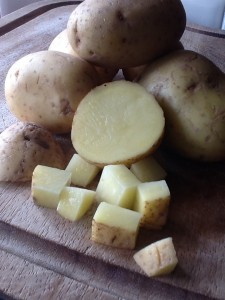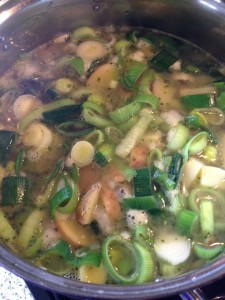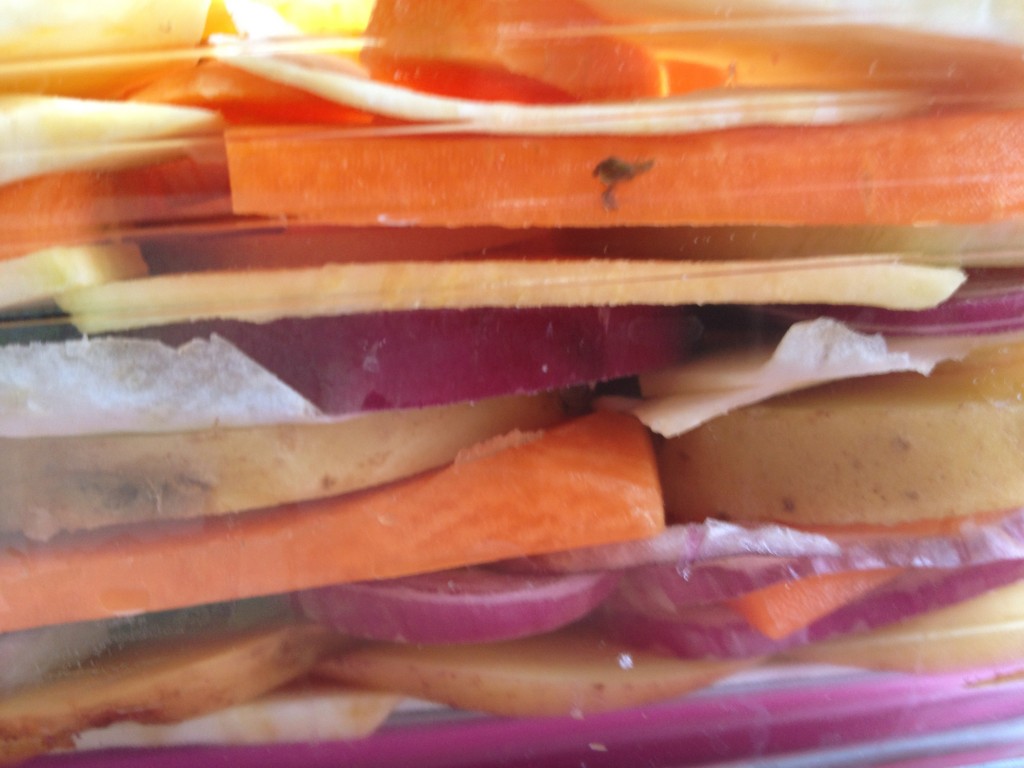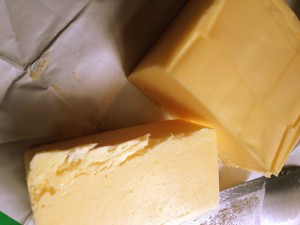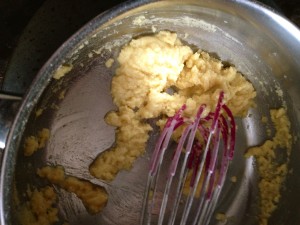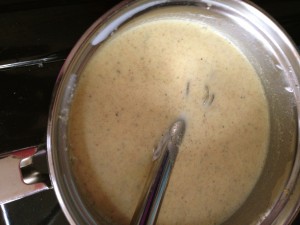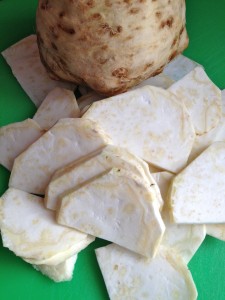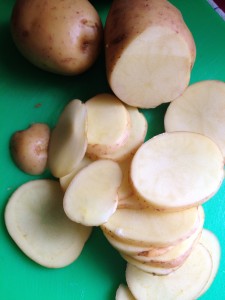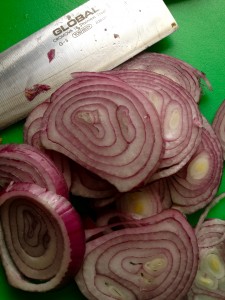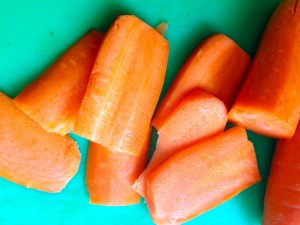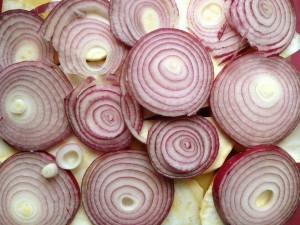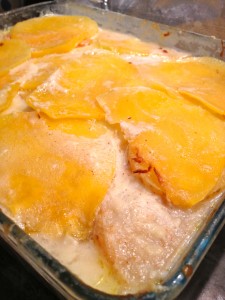As you know I’m always attempting to channel (nearly wrote Chanel…which is appropriate too) Nigella and find myself increasingly pushed for freezer space as I sling more and more stuff in that might ‘come in handy’ for a later food event (that’s known as lunch or dinner to some people). Well, I had a proper NLM (Nigella Lawson Moment) and no, before any of you wisecrackers say it, it did not involved porcelain skin, buxom curves and my cavorting in the Trevi Fountain in a posh frock…but oh how I would trade up if I could!! It involved stock (and I think the lady herself would agree that is pretty high peaking on the scale of luscious moments) – vegetable stock to be precise.
Okay, okay…
I’m over egging this. My damnable conscience is prickling my skin with disbelief at the egging, bigging and pursed-lipped bragging that just occurred. I’ll level with you, it’s just the water from various blanched, quick cooked and short boiled vegetables. In my defence I can only say I dream of Nigella’s freezers (not a euphemism) and aspire. Also, in my pitiful defence I will say this, the water from those various blanched, mostly cruciferous vegetables, is surely better to use in a soup than just flinging plain water in?!? What about just using some form of pre-made stock I hear you say, half stifling a mocking laugh. Well, I have indeed considered this idea and am a multi-user of the Marigold bouillon brand (reduced salt or organic natch) but I also wanted to create a health laden soup that can sit snug in its bowl brimming with borderline smugness at its lack of any additives except those endowed by the mother of us all…nature! What nutrients actually survive the cooking process is debatable but the water is flavoured which gives a deeper taste and loads less sodium than the bouillon. Win, win…
Jeez I needed rousing violins underscoring all that didn’t I?!
Anyhoo…at the end of the day (as people insist on saying to which the only real answer is, ‘…it gets dark’) I made a leek and potato soup that is seasonal, locally grown, the simplest ever recipe and super healthy. Hoorah.
It must be these endless wintry months that is triggering this soup obsession! Or maybe the #leekgate situation in the root vegetable bake recipe that is as yet unresolved. AND unlike the tomato soup, previously posted, this is in season now and therefore we can gorge on it without any fear of karmic damage to our carbon wotsit. Hoorah.
So literally all I do is chop up the leeks and potatoes into smallish bits. Use as much as possible of both.
Keep the skins on the potatoes. Rinse the leeks to remove any lurking soil. Then I always sauté them for a few minutes in a smidgen of olive oil. If they colour up a tad (the heat is too high?) no matter it adds a certain something, and this version isn’t going to be winning any beauty pageants any time soon…! Then I sprinkle on a touch of white pepper (adjust this seasoning later) and the bouillon powder (I usually use Marigold brand and often the reduced salt).
Then I cover the whole lot in water – the vegetable water aforementioned – stir and bring it to the boil. Don’t worry if there are any bouillon lumps they’ll soon be beaten into submission. Once it boils reduce to a simmer, partly cover and leave for fifteen/twenty minutes or so till the potatoes are cooked.
I’ve no idea how long actually I just check it and when it’s done …it’s done. Unlike boiling potatoes for mash or some such it doesn’t really matter if the whole boiling lot fall to pieces! In fact I usually let the potatoes crumble a bit then set about the whole thing with a potato masher.
The decision on the consistency of your soup is, of course, as ever, yours. Exercise this right of personal taste now. If you like a chunky, brothier soup then just mush the potatoes and leeks with the back of a wooden spoon or a potato masher to break them up until your happy. Otherwise get a trusty hand blender thingie and give it a few short blasts for a half puréed feel, or keep going until it’s a smooth blended loveliness.
Taste and adjust the seasoning…essentially the white pepper. You don’t need to add salt. Really. You don’t. I’m sure Nigella would add a swirl of cream too…but she’s a minx and I’m too vain…but I do sling a few chopped herbs on top for an added taste and nutrient kick
The winter months challenge our drive to eat locally grown produce but leeks are a fantastic gift to us. They are in season pretty much from the start of November right through till April. Chock full of healthy things like vitamins and minerals, folates and specially, like garlic and other alliums, antioxidants (notably allicin) which does lots of wondrous things like help lower cholesterol, help reduce blood pressure and, if that wasn’t enough, it acts as a general anti-bacterial, anti-viral and anti-fungal…leeks rock! If you don’t like them then either learn to like them (don’t be so nesh!) or just chuck one under your pillow to have a vision of your future loved one. Hmmm…the wives tale says ‘husband’ but I can’t believe leeks are so sexist and wouldn’t also conjure up the vision of a future wife, partner, or whatever takes your fancy…after all it’s your vision…
The humble potato, the staple of millions of tables, has a fair bit to offer on the nutrition front so rethink your opinion and, more importantly, your cooking methods. First don’t believe everything you read about GI indexes and all that, because in truth, the results vary hugely depending on considerations like type, origin, the method of cooking, even the temperature they’re eaten at, all play a part in how it breaks down in your body. Complex carbs keep you fuller longer and release slower so you have sustained energy. Potatoes (with their skins!!) have vitamins B6 (crucial for cell regeneration) and C (healthy cells, growth and repair of tissue, boosts the immune system and much more), folate and minerals such as potassium (water balance, blood pressure management, nerve function), iron (transports oxygen, helps make red blood cells, fights fatigue of body and mind) and manganese (helps utilise key nutrients, protects nerves, helps build strong bones, protects cells). They are a good source of fibre and a handful of those handy phytochemicals we need (potatoes store nutrients to fight infections and promote new growth which are thought to have antioxidant properties for us too).
A note about the Reduced Salt Marigold Swiss Vegetable bouillon. I love it, don’t get me wrong but like many, many things these days it contains palm oil. I’m a little perplexed over the palm oil sitch. Palm oil demand is huge and growing ever bigger. It is used as a cheap, trans fat free alternative to partially hydrogenated oils (which are bad and wrong) in thousands of products from foods stuffs to cosmetics. The demand has meant mass deforestation – critically in countries (like Malaysia and Indonesia) where there are several species already on the verge of extinction. Although the Marigold brand makes of point of saying their source is sustainable I wonder what the plantation replaced? AND the jury is still well and firmly still out on the health claims. The makers of the stuff claim it has a cancer fighting form of vitamin E whereas others say the high processing it goes through destroys any nutrients and health benefits and just leaves a saturated fat that doesn’t even assist cholesterol or indeed anything! Hmmm….

